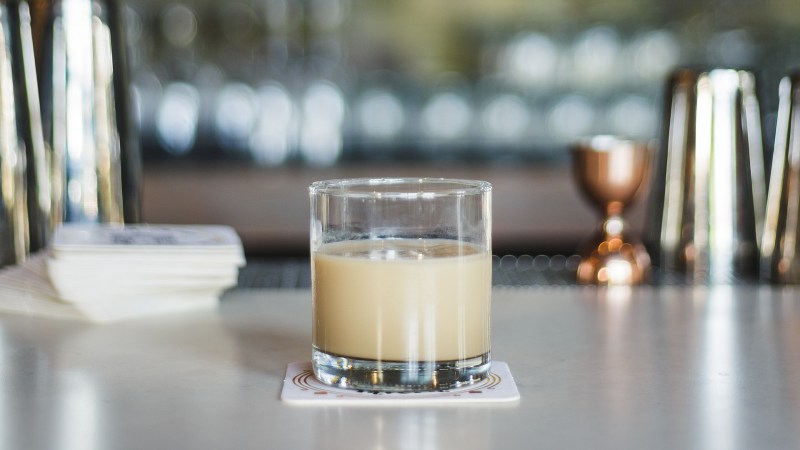
For better or worse, the White Russian will forever be tied to The Big Lebowski. While we love the Coen Brothers film from the late 90s, it doesn’t exactly elevate the classic cocktail. In fact, the way it’s cobbled together in the film, you’d think the drink was more of an act of desperation, something you put together when you’re fridge is mostly empty (and you’re wearing little more than a bathrobe).
While, will all respect to the dude himself, the White Russian deserves better. The cocktail is much more than just cream and booze, so heavy that mustering more than one takes real willpower. In reality, the White Russian is an elegant adaptation of a flip, balanced out by the bitterness of coffee and woven together by a good vodka. And you don’t just have to throw it in a crummy glass with a couple of straws (again, per the movie). So, let’s run through the very best White Russian recipe to spotlight its rightful place among the true Vodka cocktail classics.

White Russian cocktail recipe
For a proper take on the cocktail, we’ve sourced a recipe from the good folks at Death and Co. Here, half-and-half is used in place of the often and frankly, overused heavy creamer. As a result, it’s more elegant — less of a dessert and more of an anytime sipper. You’ll quickly see that this is both a great tasting and wonderful looking drink, well worth the slight added effort in the presentation department.
What you’ll need to make a White Russian:
- 1.5 oz vodka (we suggest Absolut Elyx or Reyka)
- 1 oz Caffe Lolita coffee liqueur
- 1 oz half-and-half
- 3 coffee beans for garnish
White Russian recipe steps:
- Combine vodka and liqueur in a double Old Fashioned glass.
- Fill the glass with ice cubes and stir briefly.
- Layer the half-and-half on top. Garnish with the coffee beans.
White Russian cocktail tips
There are a couple of things to get right when making an upscale White Russian. First, focus on your coffee liqueur selection. Kahlua is fine, but too sweet for many palates. Like coffee itself, the liqueur can go any number of directions in terms of the aromatics and flavors it brings to the table. We like Caffe Lolita, per the recipe above, as well as Mr. Black and the bolder flavors afforded by a label like Firelit. Taste through a few and see what you like. Chances are good that whatever you like in your favorite beans (origin, roast level, etc.) you’ll also like in what’s sourced for the liqueur.
Secondly, there’s no need to hastily throw this thing together. Stirring slowly will create a better balance and, quite frankly, it looks cooler. You can enjoy the lava lamp effect of the dairy mixing with the deep brown of the liqueur. While we strongly suggest something lighter than heavy cream, don’t go too light and use something like low-fat milk or even skim. Doing so will put you at greater risk of curdling in the drink. We’re making a pleasant cocktail here, not cheese.
Next, find a balance between liqueur and vodka. The former can come in at varying degrees of heat, so find a reasonable ABV. There’s no shame in going strong, as the added alcohol stands up to both the coffee notes and the cream, but you don’t want to make something so aggressive that the flavor of ethanol comes through. In the unlikely scenario that such a thing happens, you can always dilute a bit with added ice.
Lastly, the White Russian is a drink begging for adaptations. Try mixing in a bit of your favorite coffee or espresso. Try warming it on the stove as the days get a bit more brisk. Also, adding in spirits like Cognac or Port can add an extra layer, too.

What’s the difference between a White Russian and a Black Russian?
As cocktails go, the White Russian is a relatively new drink, with the first real documented evidence of the cocktail coming in a 1961 recipe book, which mentions the White Russian as a variant of the cocktail known as the Black Russian. The difference between the two is extremely simple: the White Russian contains cream or some other dairy product, while the Black Russian recipe omits the dairy, which gives it its namesake dark “black” color.
Connections to Belgium and Luxembourg, but not Russia
The Black Russian was allegedly invented in the late 1940s in Brussels, Belgium, by a Belgian bartender in honor of the American ambassador to Luxembourg. Since the main liquor in the drink is vodka, the name Black Russian stuck, which is the cocktail’s only connection to Russia. Still, we think it’s a good name; it’s hard to imagine the Dude drinking a White Belgian or a White Luxembourger — those names just don’t roll easily off the tongue.




